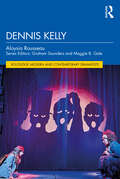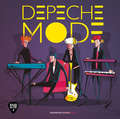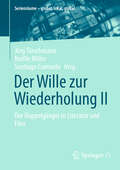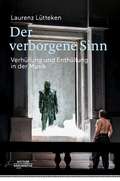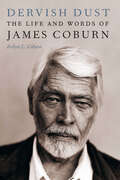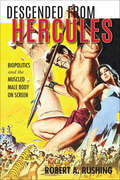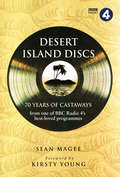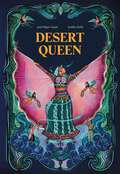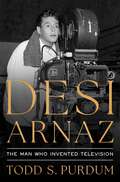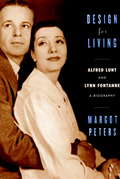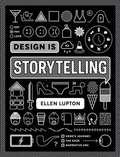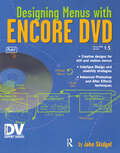- Table View
- List View
Den of Thieves (Cat Royal #3)
by Julia GoldingDisguised as a ballerina, Cat joins the French Revolution, only to find that it is up to her to save her friends after they are captured as traitors. The action-packed series continues with disguises, danger, drama, and the irrepressible Cat Royal.
Dennis Hopper: Interviews (Conversations with Filmmakers Series)
by Nick DawsonThe legendary Dennis Hopper (1936-2010) had many identities. He first broke into Hollywood as a fresh-faced young actor in the 1950s, redefined himself as a rebel director with Easy Rider in the late 1960s, and became a bad boy outcast for much of the 1970s. He returned in the 1980s with standout performances in films like Blue Velvet and Hoosiers, was one of the great blockbuster baddies of the 1990s, and ended his career as a ubiquitous actor in genre movies. Hopper, however, was much more than just an actor and director: he was also a photographer, a painter, and an art collector not to mention a longtime hedonist who kicked his addiction to drugs and alcohol and became a poster boy for sobriety. Dennis Hopper: Interviews covers every decade of his career, featuring conversations from 1957 through to 2009, and not only captures him at the significant points of his tumultuous time in Hollywood but also focuses on the lesser-known aspects of the man. In this fascinating and highly entertaining volume—the first ever collection of Hopper's interviews—he talks in depth about film, photography, art, and his battles with substance abuse and, in one instance, even takes the role of interviewer as he talks with Quentin Tarantino.
Dennis Kelly (Routledge Modern and Contemporary Dramatists)
by Aloysia RousseauDennis Kelly explores Kelly’s unusual career path and sheds light on his eclectic approach to the arts, characterised by a refusal to write texts that people can fit within neat categories. This is the first monograph on Kelly’s work for stage and screen and brings to light his essential contribution to contemporary British drama and his huge range of work including his rise to international fame with Matilda the Musical.Drawing on Kelly’s published and unpublished texts, his work in production, reviews, original interviews with directors, actors and with Kelly himself as well as critical theory, Dennis Kelly examines and reappraises key motifs in his work such as his preoccupation with violence, the complex relationship between the individual and the community or his emphasis on storytelling. It also offers new insights into overlooked aspects of Kelly’s work by setting out to explore his traumatic narratives and his post-romanticism. In keeping with Kelly’s wish never to repeat himself, this study offers multiple critical entries into his plays, television series and films, drawing on moral and political philosophy, trauma studies, studies in humour, feminist theory and film studies.Part of the Routledge Modern and Contemporary Dramatist series, Dennis Kelly is addressed to students and scholars in Drama, Theatre and Performance as well as theatre practitioners and offers in-depth analysis of one of the most unique and challenging voices in contemporary British playwriting and screenwriting.
Denys Arcand's Le Declin de l'empire americain and Les Invasions barbares
by Andrê LoiselleThe release of Denys Arcand's Le Déclin de l'empire américain (The Decline of the American Empire) in 1986 marked a major turning point in Quebec cinema. It was the first Québécois film that enjoyed huge critical and commercial success at home and abroad. Arcand's tragicomedy about eight intellectuals gathered around a dinner table relating sexy anecdotes became the top-grossing film of all time in Quebec and was the first Canadian feature to be nominated for an Oscar in the foreign-language category. Seventeen years later, Arcand won an Academy Award for the sequel, Les Invasions barbares (The Barbarian Invasions), where the amusing insouciance of the thirty-somethings talking dirty in Le Déclin is replaced by a sense of moral responsibility and serene resignation. In this engrossing study, André Loiselle presents the first in-depth analysis of both films within the context of Quebec culture. Through close readings and concise cultural analysis of two of the most important films in the history of Quebec cinema, Loiselle demonstrates the ways in which Arcand's work represents a snapshot of the evolution of the French Canadian film industry since 1980. The companion films trace the decline of Quebec's national dream and the Québécois' attempts to cling to their identity against the forces of barbaric globalization. The second title in the new Canadian Cinema series, Denys Arcand's "Le Déclin de l'empire américain" and "Les Invasions barbares" is essential reading for cinephiles, film critics, and anyone with an interest in cultural studies and Canadian and Quebec history.
Depeche Mode: El origen de la banda que conquisto el mundo con la musica electronica (Band Records)
by Soledad Romero Mariño Fernando López del HierroLos inicios de Depeche Mode, la banda de rock electrónico por excelencia, explicada a los más pequeños. <p><p>Synth pop, dance rock, new wave... Con su estilo único, el grupo británico Depeche Mode revolucionó la escena musical electrónica en los ochenta. Precursores del uso del sintetizador como instrumento, Vince Clarke, Dave Gahan, Martin Gore y Andy Fletcher se convirtieron a golpe de sampler en un auténtico fenómeno de masas. <p>Responsables de hits como «Enjoy the silence» o «Precious», sus influencias resuenan en grupos como los Pet Shop Boys o Coldplay.
Der Roman als Netzwerk: Formen, Ideen, Waren
by Corinna Norrick-Rühl Tim LanzendörferDer Roman als Netzwerk: Formen, Ideen, Waren beschäftigt sich mit dem zeitgenössischen englischsprachigen Roman und seinen Derivaten und Nebenprodukten wie Graphic Novels, Comics, Podcasts und Quality TV. Dieser Sammelband untersucht die Bedeutung des Romans im größeren System der zeitgenössischen Medienproduktion und (Post-)Printkultur und betrachtet den Roman durch die Linse der Akteur-Netzwerk-Theorie als einen Knotenpunkt im Roman-Netzwerk. Die Kapitel unterstreichen die enge Verbindung zwischen allen Aspekten des Romans, zwischen dem Roman als (literarischer) Form, als Idee und als Ware. Der Sammelband bringt Expert*innen aus amerikanischer und anglistisches Literaturwissenschaft und Postcolonial Studies sowie den Buch- und Medienwissenschaften zusammen und bietet einen neuen Blickwinkel auf den Roman in seinen vielfältigen Erscheinungsformen.
Der Wille zur Wiederholung II: Der Doppelgänger in Literatur und Film (Serienräume – global, lokal, glokal)
by Jörg Türschmann Noëlle Miller Santiago ContardoDer Band knüpft an den ersten Teil von Der Wille zur Wiederholung an, der den Untertitel Entzauberung und Faszination des Immergleichen in Literatur und Film trägt. Er widmet sich der Fiktion einer Spaltung: dem Widerspruch der Wiederholung eines Bildes in seinem Gegenbild ein und derselben Figur. Roman, Theater, Film und Fernsehen erzählen immer wieder und immer anders vom „Doppelgänger“. Sein Name ist Programm und ein Generikum, das unter der Bezeichnung Doppelganger ebenso im Englischen, Spanischen, Italienischen, Rumänischen und vielen anderen Sprachen geläufig ist. Der Germanismus steht keineswegs für kulturelle Exklusivität. Denn mit dem Aufkommen des Individualismus im 17. Jahrhundert lässt sich vielerorts ein wachsendes Interesse am Selbst und der eigenen Erfahrung beobachten wie die Erforschung des „Moi“ in Montaignes Essays. Später kreisen Psychoanalyse und Surrealismus nebst ihren postmodernen Surrogaten um das Epizentrum unbewusster Triebe mit seinem Kräftefeld aus Wünschen und Träumen. Der Doppelgänger bietet eine mögliche Darstellung eines Subjekts, das als komplex und vielschichtig verstanden wird. Im Kontext von Denkströmungen wie der Transhumanismus und die Entwicklung neuer Technologien (ChatGPT, Metaversen usw.) gewinnt dieses Thema nicht zuletzt an Aktualität, weil die digitalen Werkzeuge Strategien ermöglichen, die im Alltag die Rituale und Routinen prägen, die schon Henri Lefebvre beschreibt. Was einst eine romantische (Künstler‑)Fantasie war, kann potenziell mit den Mitteln digitaler Technik realisiert werden. Auf der einen Seite erweitern die Technologien den Subjektbegriff, auf der anderen Seite stoßen sie an die Grenzen des Bewusstseins, markiert als das Geheimnis des Menschseins. Meist bleibt es also bei einer Fantasie, die Literatur und Film gerne aus- und durchspielen. In der Fiktion ist unbestritten, dass Alltagsmenschen durch übermenschliche Kräfte zu Superhelden oder durch einen Fluch zu Monstern werden können. Angesichts dieser Fülle an figuralen Dublüren bieten die Autorinnen und Autoren dieses Bandes auf höchst anregende und abwechslungsreiche Weise Einblicke in die Diversität von Wi(e)dergänger*innen und die Synchronizität ihrer Spaltungen, Spiegelbilder, Schatten und Simulakren.
Der verborgene Sinn: Verhüllung und Enthüllung in der Musik
by Laurenz LüttekenEin Sinn, der verborgen oder enthüllt werden kann, ist eine der zentralen Denkfiguren der Neuzeit. Das betrifft auch die Frage, was Musik eigentlich sei. Je stärker man darüber nachgedacht hat, desto brüchiger, changierender ist die Annahme von einem substantiellen Wesenskern der Musik geworden. In diesem Buch geht es nicht um ästhetische oder theoretische Überlegungen dazu, sondern um die Frage, ob und auf welche Weise komponierte Musik sich selbst zum Gegenstand macht und so möglicherweise etwas von ihrem Kern preisgibt. Die optischen Metaphern von Verhüllung und Enthüllung erweisen sich dabei als ebenso hilfreich wie anschaulich. In einer Reihe von Beispielen, die vom 17. bis in die Gegenwart reichen, wird das Phänomen in seiner ganzen Vielfalt beschrieben. Dabei geht es nicht nur um Opern von Mozart bis Strauss, sondern auch um Monteverdis Vokalmusik, Haydns „Schöpfung“, die Sinfonien Bruckners oder Ligetis Etüden.
Der ästhetische Vektor: Eine Studie über filmische Postperformativität
by Jonathan ParteckeMethode der Filmrezeption. Im Zentrum dieser Methode steht der eigens definierte Begriff des ästhetischen Vektors: eine Wahrnehmungsinstanz, die als Abkürzung die Beschreibung komplizierter, semiotischer Zusammenhänge ermöglichen soll. Um den Vektorbegriff, seine Einzelteile und besondere Eigenheiten von Abänderungen und Nuancen in der Anwendung werden eine Vielzahl von neuen Begriffen eingeführt (und einige bestehende Begriffe bzw. in Verwendung befindliche Begriffe redefiniert), um eine neuartige Form der Filmwahrnehmung zu beschreiben: Das Rauschhafte Erleben des cinematographischen Modus – die Postperformativität. Film ist primär Ästhetik und Bild. Wie diese konstruiert werden und wirken, wird entschlüsselt.Der AutorJonathan Partecke studierte am Institut der Theaterwissenschaft München twm der Ludwig-Maximilians- Universität München. Seine Schwerpunkte sind: Filmwissenschaft, Ästhetiktheorie, Filmphilosophie, Deleuze.
Derrida | Benjamin: Two Plays for the Stage
by John Schad Fred DalmassoWithin the work of both Jacques Derrida and Walter Benjamin there is a buried theatricality, a theatre to-come. And in the last fifteen years there has been a growing awareness of this theatricality. To date, though, there has not been a published stage play about either Derrida or BenjaminCue Derrida| Benjamin, a volume that brings together two tragi-comic plays which mirror each other in a host of ways – above all, in the way that the central philosophical figure is displaced, or not quite where or when we would expect to find them. In Derrida’s case, it is Oxford in 1968; in Benjamin’s case, it is somewhere (or nowhere) near London in 1948. These, then, are plays in which the philosopher is exiled, or elsewhere – not quite himself. This a volume for anyone with an eye or ear for where theatre or performance meets philosophy – students, scholars, readers, actors.
Dervish Dust: The Life and Words of James Coburn
by Robyn L. CoburnDervish Dust is the authorized biography of &“cool cat&” actor James Coburn, covering his career, romances, friendships, and spirituality. Thoroughly researched with unparalleled access to Coburn&’s friends and family, the book&’s foundation is his own words in the form of letters, poetry, journals, interviews, and his previously unpublished memoirs, recorded in the months before his passing.Dervish Dust details the life of a Hollywood legend that spanned huge changes in the entertainment and filmmaking industry. Coburn grew up in Compton after his family moved from Nebraska to California during the Great Depression. His acting career began with guest character roles in popular TV series such as The Twilight Zone, Bonanza, and Rawhide. In the 1960s Coburn was cast in supporting roles in such great pictures as The Magnificent Seven, Charade, and The Great Escape, and he became a leading man with the hit Our Man Flint. In 1999 Coburn won an Academy Award for his performance in Affliction. Younger viewers will recognize him as the voice of Henry Waternoose, the cranky boss in Monsters, Inc., and as Thunder Jack in Snow Dogs. An individualist and deeply thoughtful actor, Coburn speaks candidly about acting, show business, people he liked, and people he didn&’t, with many behind-the-scenes stories from his work, including beloved classics, intellectually challenging pieces, and less well-known projects. His films helped dismantle the notorious Production Code and usher in today&’s ratings system. Known for drum circles, playing the gong, and participating in LSD research, Coburn was New Age before it had a name. He brought his motto, Go Bravely On, with him each time he arrived on the set in the final years of his life, when he did some of his best work, garnering the admiration of a whole new generation of fans.
Descended from Hercules: Biopolitics and the Muscled Male Body on Screen (New Directions in National Cinemas)
by Robert A. RushingMuscles, six-pack abs, skin, and sweat fill the screen in the tawdry and tantalizing peplum films associated with epic Italian cinema of the 1950s and 1960s. Using techniques like slow motion and stopped time, these films instill the hero's vitality with timeless admiration and immerse the hero's body in a world that is lavishly eroticized but without sexual desire. These "sword and sandal" films represent a century-long cinematic biopolitical intervention that offers the spectator an imagined form of the male body—one free of illness, degeneracy, and the burdens of poverty—that defends goodness with brute strength and perseverance, and serves as a model of ideal citizenry. Robert A. Rushing traces these epic heroes from Maciste in Cabiria in the early silent era to contemporary transnational figures like Arnold Schwarzenegger in Conan the Barbarian, and to films such as Zach Snyder's 300. Rushing explores how the very tactile modes of representation cement the genre's ideological grip on the viewer.
Desegregating Texas Schools: Eisenhower, Shivers, and the Crisis at Mansfield High
by Robyn Duff LadinoIn the famous Brown v. the Board of Education decisions of 1954 and 1955, the United States Supreme Court ruled that "separate but equal" schools for black and white students were unconstitutional. Yet history records that it took more than a decade of legal battles, civil rights protests, and, tragically, violent confrontations before black students gained full access to previously white schools. Mansfield, Texas, a small community southeast of Fort Worth, was the scene of an early school integration attempt. In this book, Robyn Duff Ladino draws on interviews with surviving participants, media reports, and archival research to provide the first full account of the Mansfield school integration crisis of 1956. Ladino explores how power politics at the local, state, and federal levels ultimately prevented the integration of Mansfield High School in 1956. Her research sheds new light on the actions of Governor Allan Shivers—who, in the eyes of the segregationists, actually validated their cause by his political actions—and it underscores President Dwight Eisenhower's public passivity toward civil rights during his first term of office. Despite the short-term failure, however, the Mansfield school integration crisis helped pave the way for the successful integration of Central High School in Little Rock, Arkansas, in 1957. Thus, it deserves a permanent place in the history of the civil rights movement, which this book amply provides.
Desert Island Discs: 70 Years of Castaways
by Sean Magee‘For seventy years now Desert Island Discs has managed that rare feat – to be both enduring and relevant. By casting away the biggest names of the day in science, business, politics, showbiz, sport and the arts, it presents a cross-sectional snapshot of the times in which we live. As the decades have passed, the programme has kept pace; never frozen in time yet always, somehow, comfortingly the same.’ Kirsty YoungBBC Radio 4’s Desert Island Discs celebrates its seventieth birthday in 2012. Since the programme’s deviser Roy Plomley interviewed comedian Vic Oliver in January 1942, nearly 3,000 distinguished people from all walks of life have been stranded on the mythical island, accompanied by only eight records, one book and a luxury.Here the story of one of BBC Radio 4’s favourite programmes is chronicled through a special selection of castaways.Roy Plomley, inventor of the programme as well as its presenter for over forty years, quizzes the young Cliff Richard about ‘these rather frenzied movements’ the 1960s pop sensation makes on the stage. Robert Maxwell tells Plomley’s successor Michael Parkinson that ‘I will have left the world a slightly better place by having lived in it.’ Diana Mosley assures Sue Lawley that Adolf Hitler was ‘extraordinarily fascinating’ and had mesmeric blue eyes. And Johnny Vegas tugs Kirsty Young’s heart-strings with his account of a childhood so impoverished that family pets were fair game: ‘My dad had always claimed that rabbits were livestock, but we’d never eaten one before.’Desert Island Discs is much more than a radio programme. It is a unique and enduringly popular take on our lives and times – and this extensively illustrated book tells in rich detail the colourful and absorbing story of an extraordinary institution.
Desert Island Discs: Fascinating facts, figures and miscellany from one of BBC Radio 4’s best-loved programmes
by Mitchell SymonsFlotsam & Jetsam is the ultimate trivia book for fans of the popular BBC Radio 4 programme Desert Island Discs, and a fascinating introduction for all those who have yet to discover its delights.Taking the reader through seven decades of wonderful entertainment, here is an absorbing range of facts, figures and miscellany – including who chose what, and why. It also reveals much about the castaways' drives and motivations, their influences and, of course, their lives.Spanning the early years with the original presenter, Roy Plomley, and the present day, the Desert Island Discs programme has brought its own unique surprises to listeners, some very personal, some humorous, such as Eric Morecambe's choice of a deckchair as his luxury and Ernie Wise's of a deckchair ticket machine.From Beethoven to the Beatles, from chessboards and chocolate to Jane Austen and Zola, Flotsam & Jetsam is the perfect companion guide to the national treasure that is Desert Island Discs.
Desert Islands and the Liquid Modern
by Barney SamsonThis book investigates desert islands in postwar anglophone popular culture, exploring representations in radio, print and screen advertising, magazine cartoons, cinema, video games, and comedy, drama and reality television. Drawing on Zygmunt Bauman’s theory of liquid modernity, desert island texts are analysed in terms of their intersections with repressive and seductive mechanisms of power. Chapters focus on the desert island as: a conflictingly in/coherent space that characterises identity as deferred and structured by choice; a location whose ‘remoteness’ undermines satirical critiques of communal identity formation; a site whose ambivalent relationship with ‘home’ and Otherness destabilises patriarchal ‘Western’ subjectivity; a space bound up with mobility and instantaneity; and an expression of radical individuality and underdetermined identity. The desert island in popular culture is shown to reflect, endorse and critique a profoundly consumerist society that seduces us with promises of coherence, with the threat of repression looming if we do not conform.
Desert Queen
by Jyoti R. GopalThis picture book biography in verse follows the life of beloved Rajasthani drag performer Queen Harish, known as the Whirling Desert Queen of Rajasthan. Lit by an inner fire and propelled by a family tragedy, Harish defied the gender conventions of middle class Indian life, battled discrimination and intimidation, and eventually grew up to dance with Bollywood movie stars and on stages across the world.Jyoti Gopal's rhythmic phrases evoke the particular sounds and beats of the music Harish danced to, and capture the passions and conflicts of his life. The poignant and inspiring tale is interpreted by internationally acclaimed Rajasthani artist Svabhu Kohli in kohl-black lines and shapes and brilliant jewel-like colors.
Desert Queen
by Jyoti R. GopalThis picture book biography in verse follows the life of beloved Rajasthani drag performer Queen Harish, known as the Whirling Desert Queen of Rajasthan. Lit by an inner fire and propelled by a family tragedy, Harish defied the gender conventions of middle class Indian life, battled discrimination and intimidation, and eventually grew up to dance with Bollywood movie stars and on stages across the world.Jyoti Gopal's rhythmic phrases evoke the particular sounds and beats of the music Harish danced to, and capture the passions and conflicts of his life. The poignant and inspiring tale is interpreted by internationally acclaimed Rajasthani artist Svabhu Kohli in kohl-black lines and shapes and brilliant jewel-like colors.
Desert Song
by Laekan Zea KempA family joins the music of the Texas desert night in this tale of tradition and memory from Pura Belpré Honor author Laekan Zea Kemp.It starts with a soft tapping,Uncle Eduardo drumming hishands against his dusty jeans.As the blush of sunset gives way to night in the desert, coyotes, cicadas, and barn owls emerge, each calling out to the moon. Watching from their porch, the family joins the song. One by one, each relative offers their drums, flute, maracas, strings, and voices. They sing with the insects, birds, snakes and toads; and they sing with their ancestors, an audience glittering in the stars overhead. With each strum of passed-down instruments, memories renew, and those gone are alive and near again.Desert Song hums and chimes with all the music a front porch and the desert beyond can hold. Pura Belpré Honor author Laekan Zea Kemp&’s masterfully stirring text dances through Beatriz Gutierrez Hernandez&’s enchanting and dynamic artwork. Readers will be left with the soothing sense that when creativity flourishes, the past is never out of reach, and the bonds that matter never break.Simultaneously published in Spanish as Canción del desierto.
Desi Arnaz: The Man Who Invented Television
by Todd S PurdumAn illuminating biography of Desi Arnaz, the visionary, trailblazing Cuban American who revolutionized television and brought laughter to millions as Lucille Ball&’s beloved husband on I Love Lucy, leaving a remarkable legacy that continues to influence American culture today.Desi Arnaz is a name that resonates with fans of classic television, but few understand the depth of his contributions to the entertainment industry. In Desi Arnaz, Todd S. Purdum offers a captivating biography that dives into the groundbreaking Latino artist and businessman known to millions as Ricky Ricardo from I Love Lucy. Beyond his iconic role, Arnaz was a pioneering entrepreneur who fundamentally transformed the television landscape. His journey from Cuban aristocracy to world-class entertainer is remarkable. After losing everything during the 1933 Cuban revolution, Arnaz reinvented himself in pre-World War II Miami, tapping into the rising demand for Latin music. By twenty, he had formed his own band and sparked the conga dance craze in America. Behind the scenes, he revolutionized television production by filming I Love Lucy before a live studio audience with synchronized cameras, a model that remains a sitcom gold standard today. Despite being underestimated due to his accent and origins, Arnaz&’s legacy is monumental. Purdum&’s biography, enriched with unpublished materials and interviews, reveals the man behind the legend and highlights his enduring contributions to pop culture and television. This book is a must-read biography about innovation, resilience and the relentless drive of a man who changed TV forever.
Desi Divas: Political Activism in South Asian American Cultural Performances
by Christine L. GarloughDesi Divas: Political Activism in South Asian American Cultural Performances is the product of five years of field research with progressive activists associated with the School for Indian Languages and Cultures (SILC), South Asian Americans Leading Together (SAALT), the feminist dance collective Post Natyam, and the grassroots feminist political organization South Asian Sisters. Christine L. Garlough explores how traditional cultural forms may be critically appropriated by marginalized groups and used as rhetorical tools to promote deliberation and debate, spur understanding and connection, broaden political engagement, and advance particular social identities. Within this framework she examines how these performance activists advocate a political commitment to both justice and care, to both deliberative discussion and deeper understanding. To consider how this might happen in diasporic performance contexts, Garlough weaves together two lines of thinking. One grows from feminist theory and draws upon a core literature concerning the ethics of care. The other comes from rhetoric, philosophy, and political science literature on recognition and acknowledgment. This dual approach is used to reflect upon South Asian American women's performances that address pressing social problems related to gender inequality, immigration rights, ethnic stereotyping, hate crimes, and religious violence. Case study chapters address the relatively unknown history of South Asian American rhetorical performances from the early 1800s to the present. Avant-garde feminist performances by the Post Natyam dance collective appropriate women's folk practices and Hindu goddess figures make rhetorical claims about hate crimes against South Asian Americans after 9/11. In Yoni ki Bat (a South Asian American version of The Vagina Monologues) a progressive performer transforms aspects of the Mahabharata narrative to address issues of sexual violence, such as incest and rape. Throughout the volume, Garlough argues that these performers rely on calls for acknowledgment that intertwine calls for justice and care. That is, they embed their testimony in traditional cultural forms to invite interest, reflection, and connection.
Design for Living: Alfred Lunt and Lynn Fontanne
by Margot PetersFrom the much-admired biographer of Charlotte Brontë, Mrs. Patrick Campbell, and the Barrymores ("Margot Peters is surely now . . . our foremost historian of stage make-believe"--Leon Edel), a new biography of the most famous English-speaking acting team of the twentieth century. Individually, they were recognized as extraordinary actors, each one a star celebrated, imitated, sought after. Together, they were legend. The Lunts. A name to conjure with. Alfred Lunt and Lynn Fontanne worked together so imaginatively, so seamlessly onstage that they seemed to fuse into one person. Offstage, they brawled so famously and raucously over every detail of every performance that they inspired the musical Kiss Me, Kate. At home on Broadway, in London's West End, touring the United States and Great Britain, and even playing "the foxhole circuit" of World War II, the Lunts stunned, moved, and mystified audiences for more than four decades. They were considered to be a rarefied taste, but when they toured Texas in the 1930s, the audience threw cowboy hats onto the stage. Their private life was equally fascinating, as unusual as the one they led in public. Friends like the critic Alexander Woollcott (whom Edna Ferber once described as "the little New Jersey Nero who thinks his pinafore is a toga"), Noël Coward, Laurette Taylor, and Sidney Greenstreet received lifelong loyalty and hospitality. Ten Chimneys, their country home in Genesee Depot, Wisconsin, "is to performers what the Vatican is to Catholics," Carol Channing once said. "The Lunts are where we all spring from. " In this new biography, Margot Peters catches the magic of Lunt and Fontanne--their period, their work, their intimacy and its contradictions--with candor, delicacy, intelligence, and wit. She writes about their personal and creative choices as deftly as she captures their world, from their meeting (backstage, naturally)--when Fontanne was a young actress in the first flush of stardom and Lunt a lanky midwesterner who came in the stage door, bowed to her elaborately, lost his balance, and fell down the stairs--and the early days when an unknown and very hungry Noël Coward lived in a swank hotel in a room the size of a closet and cadged meals at their table to the telegram the famous couple once sent to a movie mogul, turning down a studio contract worth a fortune ("We can be bought, my dear Mr. Laemmle, but we can't be bored"). We follow the Lunts through triumphs in plays such as The Guardsman, The Taming of the Shrew, and Design for Living; through friendships and feuds; through the intricate way they worked with such playwrights and directors as S. N. Behrman, Robert Sherwood, Giraudoux, Dürrenmatt, Peter Brook, and with each other. Margot Peters captures the gallantry of two remarkably gifted people who lived for their art and for each other. Alfred Lunt and Lynn Fontanne were once described as an "amazing duet of intelligence and gaiety. " Margot Peters re-creates the fun and the fireworks. From the Hardcover edition.
Design for Motion
by Austin ShawPlumb the depths of core motion design fundamentals and harness the essential techniques of this diverse and innovative medium. Combine basic art and design principles with creative storytelling to create compelling style frames, design boards, and motion design projects. Here, in one volume, Austin Shaw covers all the principles any serious motion designer needs to know in order to make their artistic visions a reality and confidently produce compositions for clients, including: Illustration techniques Typography Compositing Cinematography Incorporating 3D elements Matte painting Concept development, and much more Lessons are augmented by illustrious full color imagery and practical exercises, allowing you to put the techniques covered into immediate practical context. Industry leaders and pioneers, including Karin Fong, Bradley G Munkowitz (GMUNK), Will Hyde, Erin Sarofsky, Danny Yount, and many more, contribute their professional perspectives, share personal stories, and provide visual examples of their work. Additionally, a robust companion website (www.focalpress.com/cw/shaw) features project files, video tutorials, bonus PDFs, and rolling updates to keep you informed on the latest developments in the field.
Design is Storytelling
by Ellen LuptonA playbook for creative thinking, created for contemporary students and practitioners working across the fields of graphic design, product design, service design and user experience. Design Is Storytelling explores the psychology of visual perception from a narrative point of view. Presenting dozens of tools and concepts in a lively, visual manner, this book will help any designer amplify the narrative power of their work. Use this book to stir emotions, build empathy, articulate values and convey action; to construct narrative arcs and create paths through space; integrate form and language; evaluate a project’s storytelling power; and to write and deliver strong narratives.
Designing Menus with Encore DVD
by John SkidgelDesigned to complement the Encore DVD software documentation, this full-color book begins with a brief description of the DVD specification, then introduces readers to DVD authoring concepts such as menu creation, timeline construction, navigation, transcoding, and disc mastering. Readers learn how to plan and manage projects, and how to master the workflows between Encore and other Adobe applications such as Photoshop, Premiere, and After Effects to create well-structured and engaging menus. The companion DVD contains documents for planning a DVD, tutorial projects, and a library of royalty free, customizable, templates.


